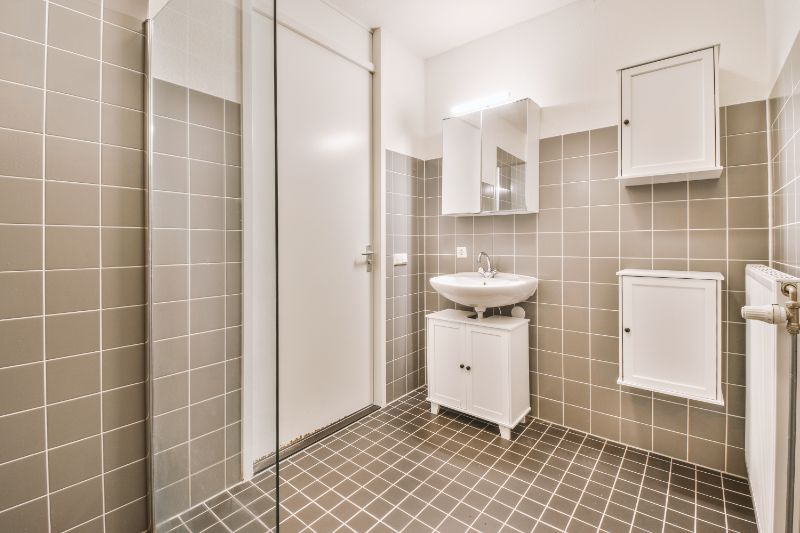San Diego California Ceramic Tile Refinishing
If you’re tired of looking at outdated, worn-out tile but dreading the cost and hassle of a full replacement, ceramic tile refinishing may be the perfect solution for you. Refinishing ceramic tiles can transform the look of your kitchen, bathroom, or any tiled surface without the need for messy and expensive replacements. At FG Tub & Tile, we specialize in offering top-notch tile refinishing services that give your home a fresh, updated appearance at a fraction of the cost and time of a full renovation.
What Is Ceramic Tile Refinishing?
Ceramic tile refinishing is a process that restores the look and durability of your existing tiles by applying a new surface coating. This technique involves cleaning, repairing, and resurfacing your tiles, giving them a fresh, glossy finish. Whether it’s for your kitchen countertops, bathroom walls, or floors, refinishing is a much better option to replacing ceramic tiles.

Benefits of Tile Refinishing Over Replacement
Many homeowners believe that the only way to refresh their space is by completely removing and replacing old tiles. However, refinishing offers several advantages over replacement:
Cost Savings: Refinishing is significantly less expensive than tile replacement. You avoid the cost of new tiles, labor, and the time involved in tearing out and disposing of the old materials.
Minimal Disruption: Unlike a full tile replacement, which can take days or weeks, refinishing can be completed in as little as one day, depending on the size of the project.
Eco-Friendly: Refinishing your tiles reduces waste, as you’re not throwing away old materials, making it a more environmentally friendly option.
Enhanced Durability: A new surface coating can extend the lifespan of your tile, making it resistant to moisture, dirt, and everyday wear and tear.
Why Choose Ceramic Tile Refinishing?
A Much Better Option to Replacing Ceramic Tile
Refinishing your ceramic tile provides a fresh, modern look without the mess of removal and replacement. Not only is it less expensive, but it’s also far superior in terms of time savings and hassle. You won’t be able to tell the difference between newly refinished tile and brand-new tile—but your wallet certainly will!
Extend the Lifespan of Your Tiles
Ceramic tiles are incredibly durable, but over time they can begin to show signs of wear, such as chips, cracks, or discoloration. Instead of replacing the tiles entirely, refinishing allows you to repair and restore the existing surfaces. The new surface is not only aesthetically pleasing but also adds a protective layer, helping prevent further damage from moisture, soap residue, and everyday wear.
The Refinishing Process: How Does It Work?
The tile refinishing process is straightforward but requires skill and precision to achieve the best results. Here’s an overview of how our team at FG Tub & Tile approaches every refinishing project:
Surface Preparation: First, we thoroughly clean the tile surface to remove dirt, soap scum, and grime. Any chips or cracks are repaired to create a smooth base for the new coating.
Sanding and Bonding: Using fine-grit sandpaper, we lightly sand the tiles to ensure the new coating adheres properly. A bonding agent is then applied to create a strong bond between the existing tile and the refinishing materials.
Application of Coating: Once the surface is prepped, we apply several layers of high-quality refinishing coatings. These coatings not only give the tiles a new life but also protect them from future wear and damage.
Final Touches: After the coatings have dried, we inspect the newly refinished tile for any imperfections. Once the finish is perfect, we clean the area and ensure that the tiles have a glossy, durable, and attractive new surface.
Common Areas for Tile Refinishing
While most people associate tile refinishing with bathrooms, it can be used in a variety of areas throughout the home. Some of the most common surfaces we refinish include:
Bathroom Tiles
Refinishing is an ideal solution for shower walls, floors, and bathtub surrounds. Tiles that have become dull, stained, or damaged can be restored to look like new without the need for removal or replacement.
Kitchen Countertops and Backsplashes
If your kitchen tiles are showing signs of wear or have fallen out of style, refinishing can give your countertops and backsplashes a fresh look. You can also choose from a variety of colors and finishes to match your updated decor.
Floor Tiles
Floor tiles can take a beating over time, especially in high-traffic areas like entryways and kitchens. Refinishing is a cost-effective way to renew the appearance of your floor tiles and protect them from future damage.
How Much Does Ceramic Tile Refinishing Cost?
The cost of ceramic tile refinishing depends on several factors, including the size of the area, the condition of the tiles, and the type of finish you choose. However, on average, refinishing costs can be up to 75% less than a complete tile replacement. At FG Tub & Tile, we offer competitive pricing and will provide you with a detailed quote before starting any project.
How Long Does Tile Refinishing Last?
With proper care and maintenance, refinished tiles can last for many years. The key to extending the lifespan of refinished tiles is regular cleaning with non-abrasive cleaners and avoiding harsh scrubbing tools like steel wool, which can damage the surface. At FG Tub & Tile, we use high-quality coatings that are designed to be durable and long-lasting, ensuring that your tiles maintain their fresh look for years to come.

When Should You Consider Replacing Instead of Refinishing?
While refinishing is a great option in most cases, there are situations where replacing tiles might be necessary:
Severely Damaged Tiles: If the tiles are cracked or broken beyond repair, refinishing may not be the best option.
Structural Issues: If the underlying substrate is damaged, simply refinishing the surface won’t solve the problem. In these cases, replacement may be required to address the structural integrity of the tile surface.
Significant Mold or Water Damage: If moisture has penetrated behind the tiles and caused mold or water damage, replacing the affected area may be necessary before refinishing.
Why Choose FG Tub & Tile for Your Refinishing Project?
At FG Tub & Tile, we are committed to providing the highest quality tile refinishing services. Our team of experts specializes in restoring your tiles to their former glory, offering you a long-lasting and cost-effective alternative to full replacement. When you choose us, you’re not just getting a service—you’re getting peace of mind, knowing your home is in capable hands.
Customer-Centric Approach
We prioritize customer satisfaction and are dedicated to delivering results that exceed expectations. Our refinishing projects are backed by a satisfaction guarantee, and we’re always available to consult with you throughout the entire process.
Eco-Friendly Solutions
Tile refinishing is not only cost-effective but also an eco-friendly option that reduces the need for disposing of old materials. By choosing refinishing over replacement, you’re making a sustainable choice that benefits both your home and the environment.
Contact Us Today for a Free Quote!
If you’re ready to give your home a fresh new look with ceramic tile refinishing, contact us at FG Tub & Tile. Our team is standing by to help you transform your space with professional, durable refinishing solutions. Avoid the mess of replacement and renew your tiles today!
